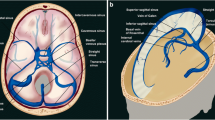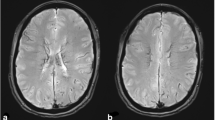Abstract
Background
Despite recent advances, the clinical features of cerebral venous thrombosis (CVT) remain incompletely characterized. To our knowledge, no case series have been reported from North American centers with detailed long-term outcome data, and few studies have evaluated recanalization rates.
Methods
All cases of CVT at a single tertiary care hospital between 1995 and 2004 were retrospectively reviewed. Follow-up information was obtained from direct patient interviews.
Results
Follow-up data were available for 58 of 61 CVT patients (median 50 months). Average age was 40, and 66% were women. Headache and focal neurological deficits were noted in 82% and 72%, respectively. Intracranial hemorrhage was seen in 44%. Hypercoagulable risk factors were identified in 84%. Anticoagulation was initiated acutely in 84%, including in all patients with intraparenchymal hemorrhage (IPH). The percentage of patients with a modified Rankin Score (mRS) of 0 to 2 at admission, hospital discharge and last follow-up were 41%, 67%, 90%, respectively; the rate of favorable long-term outcome did not differ significantly between patients with and without IPH. In the subset of 21 patients with follow-up imaging available for direct review, 90% had partial or complete recanalization.
Conclusions
The demographics, clinical presentation, imaging findings, and risk factors in this large North American cohort of CVT patients strongly support the observations of previous European case series. In addition, the favorable long-term outcome and recanalization rates observed lend further support to the safety and efficacy of acute heparin therapy for the treatment of symptomatic CVT (irrespective of the presence of ICH).



Similar content being viewed by others
References
Ferro JM, Canhao P, Stam J, Bousser MG, Barinagarrementeria F. Prognosis of cerebral vein and dural sinus thrombosis: Results of the international study on cerebral vein and dural sinus thrombosis (iscvt). Stroke. 2004;35:664–70. doi:10.1161/01.STR.0000117571.76197.26.
Selim M, Caplan LR. Radiological diagnosis of cerebral venous thrombosis. Front Neurol Neurosci. 2008;23:96–111.
Stam J, de Bruijn S, deVeber G. Anticoagulation for cerebral sinus thrombosis. Stroke. 2003;34:1054–5. doi:10.1161/01.STR.0000062344.87396.72.
Albers GW, Amarenco P, Easton JD, Sacco RL, Teal P. Antithrombotic and thrombolytic therapy for ischemic stroke: the seventh accp conference on antithrombotic and thrombolytic therapy. Chest. 2004;126:483S–512S. doi:10.1378/chest.126.3_suppl.483S.
Wasay M, Bakshi R, Kojan S, Bobustuc G, Dubey N, Unwin DH. Nonrandomized comparison of local urokinase thrombolysis versus systemic heparin anticoagulation for superior sagittal sinus thrombosis. Stroke. 2001;32:2310–7. doi:10.1161/hs1001.096192.
Summers SM. Transverse sinus thrombosis with hemorrhagic venous infarction treated with thrombectomy, endovascular tissue plasminogen activator, and systemic anticoagulation. J Emerg Med. 2009 (Epub ahead of print).
Dentali F, Gianni M, Crowther MA, Ageno W. Natural history of cerebral vein thrombosis: a systematic review. Blood. 2006;108:1129–34. doi:10.1182/blood-2005-12-4795.
Stolz E, Trittmacher S, Rahimi A, Gerriets T, Rottger C, Siekmann R, et al. Influence of recanalization on outcome in dural sinus thrombosis: a prospective study. Stroke. 2004;35:544–7. doi:10.1161/01.STR.0000112972.09096.65.
Gosk-Bierska I, Wysokinski W, Brown RD Jr, Karnicki K, Grill D, Wiste H, et al. Cerebral venous sinus thrombosis: incidence of venous thrombosis recurrence and survival. Neurology. 2006;67:814–9. doi:10.1212/01.wnl.0000233887.17638.d0.
Wasay M, Bakshi R, Bobustuc G, Kojan S, Sheikh Z, Dai A, et al. Cerebral venous thrombosis: analysis of a multicenter cohort from the United States. J Stroke Cerebrovasc Dis. 2008;17:49–54. doi:10.1016/j.jstrokecerebrovasdis.2007.10.001.
Tsai LK, Jeng JS, Liu HM, Wang HJ, Yip PK. Intracranial dural arteriovenous fistulas with or without cerebral sinus thrombosis: analysis of 69 patients. J Neurol Neurosurg Psychiatry. 2004;75:1639–41. doi:10.1136/jnnp.2003.026583.
Singh V, Smith WS, Lawton MT, Halbach VV, Young WL. Risk factors for hemorrhagic presentation in patients with dural arteriovenous fistulae. Neurosurgery. 2008;62:628–35. doi:10.1227/01.neu.0000317311.69697.fc. discussion 628-635.
Bousser MG, Ferro JM. Cerebral venous thrombosis: an update. Lancet Neurol. 2007;6:162–70. doi:10.1016/S1474-4422(07)70029-7.
Stolz E, Rahimi A, Gerriets T, Kraus J, Kaps M. Cerebral venous thrombosis: an all or nothing disease? Prognostic factors and long-term outcome. Clin Neurol Neurosurg. 2005;107:99–107. doi:10.1016/j.clineuro.2004.06.002.
Author information
Authors and Affiliations
Corresponding author
Additional information
Joey D. English and Jeremy D. Fields contributed equally to this manuscript.
Rights and permissions
About this article
Cite this article
English, J.D., Fields, J.D., Le, S. et al. Clinical Presentation and Long-Term Outcome of Cerebral Venous Thrombosis. Neurocrit Care 11, 330–337 (2009). https://doi.org/10.1007/s12028-009-9234-8
Received:
Accepted:
Published:
Issue Date:
DOI: https://doi.org/10.1007/s12028-009-9234-8




